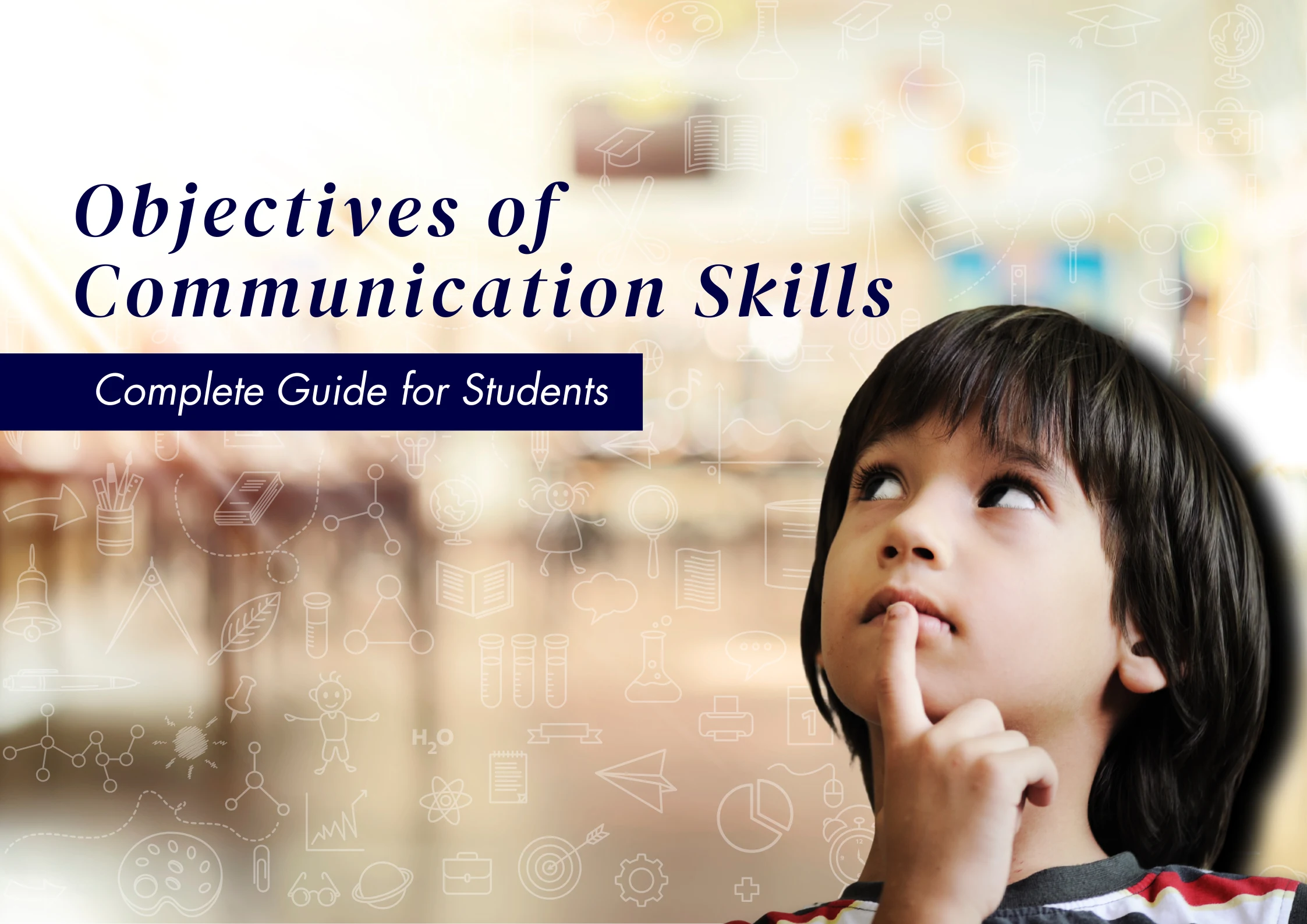
Imagine a student confidently presenting a science project to the class as they listen intently. That confidence develops through daily practice and comprehension of the objectives of communication skills, it does not appear overnight. Effective communication is now essential for both academic success and future employment, whether you are preparing for group discussions, class presentations, or campus interviews.
Understanding Communication Skills:

Communication skills are the abilities that help you share information, ideas and feelings effectively. For students, these soft skills are not limited to speaking in English fluently. They include listening carefully, writing clearly, presenting logically and even using digital tools politely.
In today’s classrooms and virtual learning spaces, communication has four main forms:
- Verbal communication: the words you speak in discussions, debates and oral exams.
- Non-verbal communication: gestures, facial expressions and body language that support or sometimes contradict your words.
- Written communication: essays, emails, project reports and even social media posts.
- Digital communication: video calls, online classes and messages where netiquette matters.
When these skills work together, they make learning more interactive and help you build lasting academic and personal relationships.
Aims of Developing Communication Skills in Students:

Before we talk about the objectives of communication skills, it helps to understand the broader aims. Aims are long-term goals the bigger picture of why you want to be a good communicator. For students, key aims include:
- Building confidence: feeling comfortable expressing ideas in front of teachers and peers.
- Improving teamwork: collaborating smoothly in projects and group activities.
- Enhancing critical thinking: explaining your reasoning and responding to questions.
- Preparing for the future: becoming ready for interviews, internships and professional careers in a global environment.
These aims show why communication skills are a foundation for success beyond textbooks.
Objectives of Communication Skills:

While aims describe the “why,” objectives of communication skills explain the “how.” They are measurable steps that lead you toward those bigger goals. For students, the most important objectives are:
Expressing ideas clearly – learning to present thoughts in a logical, concise and well-structured way so others can easily understand you.
Active listening and empathy – focusing on what others say, asking clarifying questions and showing that you value different perspectives.
Effective presentation of information – using voice modulation, eye contact and clear visuals when speaking in class or during a seminar.
Adapting to different audiences – choosing words and tone to suit teachers, classmates, or an interview panel.
Using digital and written channels properly – writing professional emails, participating in online discussions and following proper digital etiquette.
Cross-cultural understanding – communicating respectfully with people from different regions, cultures or languages, a key skill in today’s global classrooms.
These objectives give you a roadmap for practice and improvement. They also make it possible to measure progress—for example, being able to deliver a five-minute talk without filler words or receiving positive feedback on a group presentation.
How can students achieve these objectives?

Knowing the objectives is only the first step; achieving them requires consistent effort. Here are simple yet powerful ways students can practise every day:
- Class participation: Ask questions and share ideas during lessons to build confidence.
- Peer feedback sessions: Exchange constructive comments on presentations or essays to improve listening and speaking.
- Debate or drama clubs: Regular participation sharpens verbal and non-verbal communication.
- Daily writing habit: Maintain a journal or blog to strengthen written expression.
- Digital etiquette practice: Use polite and professional language in emails and online group chats.
- Video practice: Record yourself giving a short speech and review it to notice body language and tone.
By turning these habits into a routine, you steadily move closer to mastering the objectives of communication skills.
Overcoming Barriers to Strong Communication:
Even motivated students face obstacles. Recognising these barriers and tackling them ensures steady growth.
- Stage fright or shyness: Begin with small groups and gradually increase audience size. Breathing exercises and preparation reduce anxiety.
- Language limitations: Improve vocabulary and grammar through reading and daily conversations in the target language.
- Cultural differences: Learn about the customs and communication styles of diverse groups to avoid misunderstandings.
- Fear of making mistakes: Treat errors as learning opportunities and seek constructive feedback.
By addressing these barriers early, you build resilience and confidence.
Assessing Progress and Measuring Success:

Progress in communication is not just a feeling; it can be tracked.
Students can:
- Self-assess: Keep a log of presentations, noting what went well and what to improve.
- Seek teacher feedback: Ask for comments on clarity, structure and delivery.
- Peer evaluation: Exchange constructive critiques with classmates after group tasks.
- Use rubrics: Rate skills like eye contact, voice clarity and content organisation on a simple scale.
Regular assessment shows which objectives have been met and where to focus next.
Frequently Asked Questions (FAQs)
Ques 1. What are the main objectives of communication skills for students?
Ans. The main objectives of communication skills are to help students express ideas clearly, listen actively, present information effectively, adapt to different audiences and use digital tools with proper etiquette.
Ques 2. Why are communication skills important in a student’s life?
Ans. Strong communication skills improve teamwork, build confidence, enhance academic performance and prepare students for interviews and professional careers.
Ques 3. How can students improve their verbal communication skills?
Ans. Students can improve by participating in debates, giving class presentations, practising storytelling and holding regular discussions with peers.
Ques 4. How do non-verbal cues enhance communication?
Ans. Body language, gestures and facial expressions add meaning to spoken words and help convey emotions more effectively.
Ques 5. What are common barriers to communication skills?
Ans. Barriers include stage fright, language limitations, cultural differences, distractions and fear of making mistakes.



